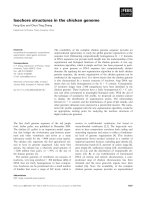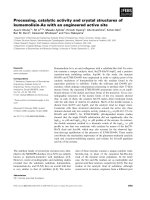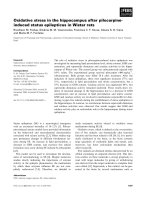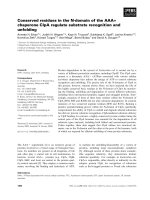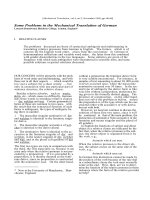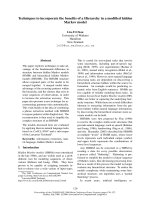Báo cáo khoa hoc:" Perfluorodecaline residue in the anterior chamber of a patient with an intact crystalline lens: a case report" ppt
Bạn đang xem bản rút gọn của tài liệu. Xem và tải ngay bản đầy đủ của tài liệu tại đây (251.46 KB, 3 trang )
BioMed Central
Page 1 of 3
(page number not for citation purposes)
Journal of Medical Case Reports
Open Access
Case report
Perfluorodecaline residue in the anterior chamber of a patient with
an intact crystalline lens: a case report
Erdinc Aydin* and Helin Deniz Demir
Address: Department of Ophthalmology, Gaziosmanpasa University School of Medicine, Tokat, Turkey
Email: Erdinc Aydin* - ; Helin Deniz Demir -
* Corresponding author
Abstract
Background: Perfluorocarbon liquids are frequently used as intraoperative tools in vitreoretinal
surgery and may occasionally be retained in the vitreous cavity. We report a patient who
underwent pars plana vitrectomy for a giant tear after receiving blunt trauma to his right eye and
sustained postoperative perfluorocarbon liquid residue in the anterior chamber in spite of an intact
crystalline lens.
Case presentation: Perfluorodecaline was used as a temporary retinal tamponade. Three weeks
after the surgery, a residue of heavy liquid was observed in the anterior chamber, even though the
patient had an intact crystalline lens without any tilt or dislocation. The remnant of the heavy liquid
was taken out of the anterior chamber immediately to avoid secondary complications.
Conclusion: Presence of heavy liquids in the anterior chamber may be associated with zonular
defects even though the patient has an intact crystalline lens.
Background
Perfluorocarbon liquids (PFCLs) with high specific gravity
relative to aqueous or subretinal fluid have been fre-
quently used as intraoperative tools and a short-term tam-
ponade in vitreoretinal surgery [1]. It is usually removed
at the end of the procedure; however, occasionally residue
may be retained due to hazy media. Some clinical reports
have been presented in the literature about remnants of
perfluorodecaline in the anterior segment [2,3].
We report a case of a patient with perfluorodecaline in the
anterior chamber who had an intact crystalline lens fol-
lowing pars plana vitrectomy.
Case presentation
A 17-year-old male with progressive visual loss and pho-
topsia was admitted to our ophthalmology clinic. He had
a history of blunt trauma with a basketball to his right eye
6 months ago and had begun to suffer from visual distur-
bances since then. His visual acuity (VA) was 20/400 in
his right eye. Dilated fundus exam of his right eye revealed
a giant tear in the superotemporal retina with a shallow
retinal detachment involving the macula (Figure 1a and
1b). His visual acuity was 20/20 and anterior and poste-
rior segments were normal in the left eye. He underwent a
three-port pars plana vitrectomy for the giant tear without
crystalline lens extraction. Perfluorodecaline was used
intraoperatively. Three weeks postoperatively, perfluoro-
decaline was observed in the anterior chamber in contact
with the corneal endothelium (Figure 2). No tilt or dislo-
cation of the crystalline lens was detected on slit lamp
biomicroscopy. We referred our patient to another eye
clinic for ultrasound biomicroscopic (UBM) or endo-
scopic examination in order to determine zonular dialy-
Published: 22 January 2008
Journal of Medical Case Reports 2008, 2:13 doi:10.1186/1752-1947-2-13
Received: 30 July 2007
Accepted: 22 January 2008
This article is available from: />© 2008 Aydin and Demir; licensee BioMed Central Ltd.
This is an Open Access article distributed under the terms of the Creative Commons Attribution License ( />),
which permits unrestricted use, distribution, and reproduction in any medium, provided the original work is properly cited.
Journal of Medical Case Reports 2008, 2:13 />Page 2 of 3
(page number not for citation purposes)
sis, but could not obtain these results as the patient
refused (4)
After our attempt to remove the perfluorodecaline in the
anterior chamber with a 27G needle failed, an anterior
chamber wash was performed with balanced salt solution
via two wide paracentesis. Two months after vitreoretinal
surgery, his best-corrected visual acuity (BCVA) was 40/
200 in the right eye. The vision and retina remained stable
in his follow-up (Figure 1c).
Conclusion
Residual PFCLs droplets may pass through inferior iridec-
tomies, and the pupil of aphakic eyes as well as retinal
holes if there is residual traction, even though have high
surface tension. Their usage as temporary tamponade in
human eyes is reported to be well tolerated [4][5]. How-
ever, corneal toxicity has also been reported for per-
fluorooctane, perfluoropolyether and perfluoro-
phenanthrene [2,3]. Perfluorodecaline may also have a
role in the etiology of some changes, such as corneal
oedema and deep corneal vascularization in the area of
perfluorodecaline-endothelial contact. It is known that
corneal decompensation due to perfluorodecaline-
endothelial contact occurs after 4 to 13 weeks, and pene-
trating keratoplasties can be performed for progressive
corneal oedema. Corneal toxicity may be induced by
intraocular perfluorodecaline if direct contact is allowed
with the corneal endothelium for a period (sometimes as
short as 1-month).
Some of these changes may be reversible if perfluorodec-
aline is aspirated from the anterior chamber [3]. It is
assumed that mechanical or the barrier effects of perfluor-
odecaline may cause the loss of cell density and morpho-
logical changes. For these reasons, we decided to remove
the perfluorodecaline without any delay.
In the case presented here, we would like to demonstrate
that even though the patient has an intact crystalline lens,
PFCLs may be postoperatively encountered in the anterior
chamber due to zonular defects during vitrectomy surgery
or in eyes with trauma.
Concent
Written consent of the patient was obtained for publica-
tion of this case report.
Competing interests
The author(s) declare that they have no competing inter-
ests.
Colour images of perfluorodecalin residue in anterior cham-ber of a 17-year-old male with an intact crystalline lensFigure 2
Colour images of perfluorodecalin residue in anterior cham-
ber of a 17-year-old male with an intact crystalline lens.
Colour images of the retina before and after operationFigure 1
Colour images of the retina before and after operation. (a and b) Giant retinal tear with shallow detached retina involving the
macula in the right eye. (c) Reattachment of retina after vitrectomy.
Publish with BioMed Central and every
scientist can read your work free of charge
"BioMed Central will be the most significant development for
disseminating the results of biomedical research in our lifetime."
Sir Paul Nurse, Cancer Research UK
Your research papers will be:
available free of charge to the entire biomedical community
peer reviewed and published immediately upon acceptance
cited in PubMed and archived on PubMed Central
yours — you keep the copyright
Submit your manuscript here:
/>BioMedcentral
Journal of Medical Case Reports 2008, 2:13 />Page 3 of 3
(page number not for citation purposes)
Authors' contributions
EA wrote up the case and collected the data
HDD supervised management of the case
Acknowledgements
The authors declare that no funding was required for the writing and sub-
mission of the manuscript.
References
1. Chang S, Lincoff H, Zimmerman NJ, Fuchs W: Giant retinal tears:
surgical techniques and results using perfluorocarbon liq-
uids. Arch Ophthalmol 1989, 107:761-766.
2. Moreira H, de Queiroz JM Jr, Liggett PE, Mc Donnell PJ: Corneal
toxicity study of two perfluorocarbon liquids in rabbit eyes.
Cornea 1992, 11:376-9.
3. Willbanks GA, Apel AJ, Jolly SS, Devenyi RG, Rootmann DS: Per-
fluorodecaline corneal toxicity: five case reports. Cornea 1996,
15(3):329-34.
4. Stolba U, Krepler K, Velikay M, Binder S: Anterior segment
changes in rabbits after experimental aqueous replacement
with various amounts of different perfluorocarbon liquids.
Graefe's Arch Clin Exp Ophthalmol 1999, 237:501-507.
5. Bottoni F, Sborgia M, Arpa P, et al.: Perfluorocarbon liquids as
postoperative short-term vitreous substitutes in compli-
cated retinal detachment. Graefe's Arch Clin Exp Ophthalmol 1993,
231:619-28.



